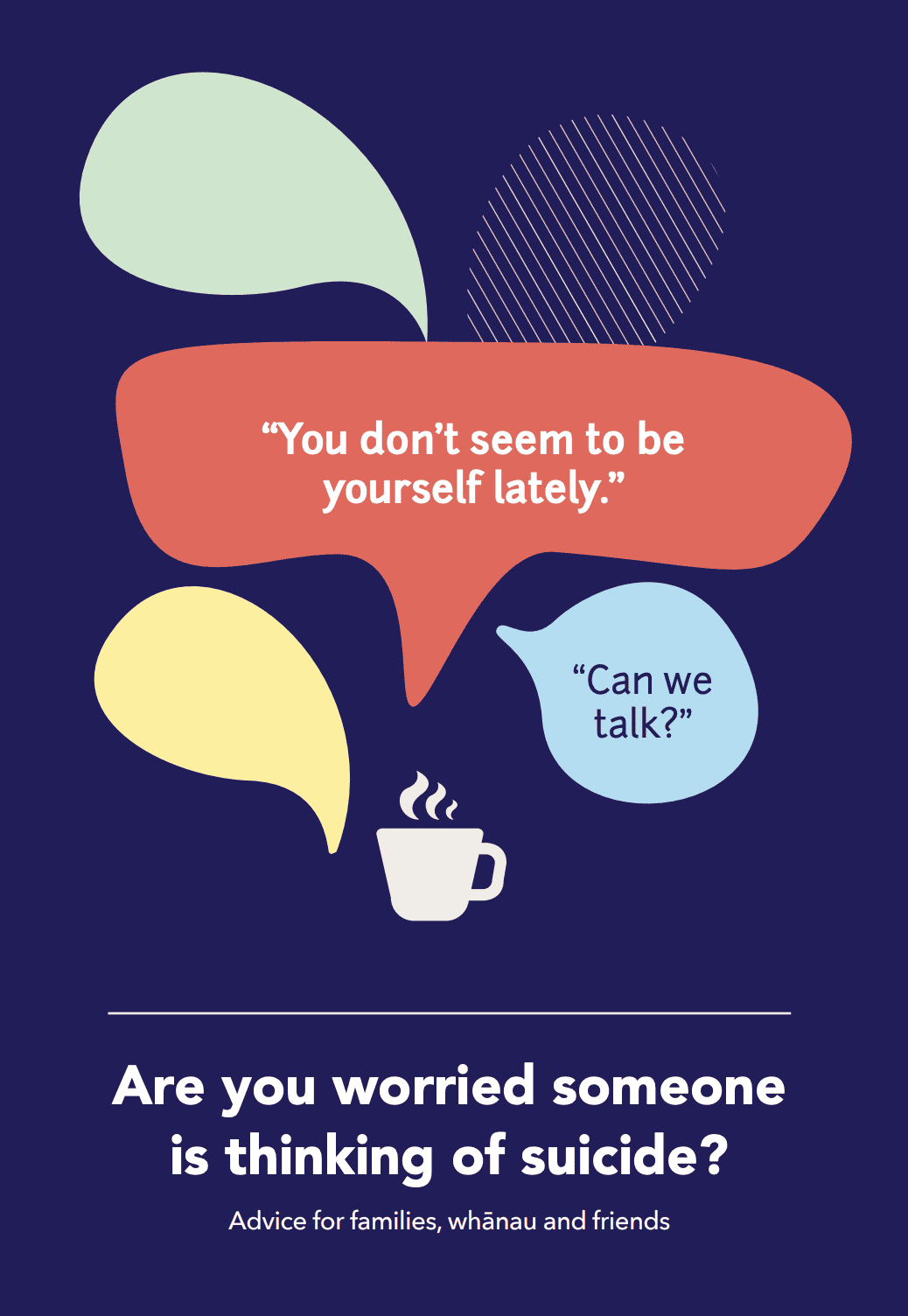"*" indicates required fields

Helping a Man at Risk of Suicide
It is distressing to realise that someone close to you may be considering suicide. The below information will help you in helping someone with suicidal thoughts; to identify signs to look for, decide what to do and learn what help is available. Most people who consider suicide do get through the crisis. Family, friends and professionals can make a big difference in helping people stay safe and re-establish reasons for living.
Men who have experienced child sexual abuse and suicidal thoughts
Suicidal thoughts can be a recurring theme for some men who have experienced child sexual abuse or sexual assault. Talk of suicide should always be taken seriously, particularly as research suggests that men who were sexually abused are up to 10 times more likely to experience suicidal thoughts. In one study, 46% of men with a history of childhood sexual abuse indicated that they had attempted suicide. Add to this the fact that males are almost 4 times more likely than females to die by suicide (with men in age 30-44 years the most at risk) then it becomes important to be prepared to ask about and deal with suicidal thoughts.
Behaviours to look out for – what is he doing?
People at risk of suicide usually give clues by their behaviour. These may include:
- Previous suicide attempts
- Being moody, sad and withdrawn
- Talking of feeling hopeless, helpless or worthless
- Taking less care of himself and his appearance
- Losing interest in things he previously enjoyed
- Finding it hard to concentrate
- Being more irritable or agitated
- Talking or joking about suicide
- Expressing thoughts about death through drawings, stories, songs etc
- Saying goodbye to others and/or giving away his possessions
- Engaging in risky or self-destructive behaviour
- Increasing alcohol/drug use
Talk of suicide should always be taken seriously.
Most people who think of suicide do get through it.
Mental Health
Mental health problems can increase the risk of suicide. We may not know a person’s mental health history; however, we may notice that a person seems depressed or anxious, and/or is misusing alcohol or other drugs. They may have told us that they are receiving treatment for a mental health problem.
Having a mental health problem does not mean a person will have thoughts of suicide – many don’t. However, mental health problems can affect the way people view problems. They affect motivation and openness to seek help, therefore we need to be particularly aware of the possible risk of suicide.
People who have recently been discharged from hospital for treatment of mental health problems may also be at higher risk of suicide. It is important that they receive ongoing support in the community. You may be able to help by supporting them to attend any follow-up visits with their GP or mental health specialists.
What do I do now?
People considering suicide often feel very isolated and alone. They may feel that nobody can help them or understand their psychological pain. When unable to see any other way of dealing with pain, suicide may seem to be a way out. Sometimes people who have been distressed and openly suicidal become outwardly calm. Be aware that this may mean many things, including their quiet resolution to complete their suicide plan.
The important thing to remember is that if someone is not their usual self or if they are showing signs that arouse your concern you need to check it out. This tool kit will help you to talk to someone about suicide and then decide what steps to take.
Most people who consider suicide get through the crisis. The help and support of family, friends and professionals can make a big difference. The following tips will help you know what to do.
Practical steps you can take
1) Do something now
If you are concerned that someone you know is considering suicide, act promptly. Don’t assume that they will get better without help or that they will seek help on their own. It’s easy to avoid being part of that help, or to hope that someone else will step in. Reaching out now could save a life.
2) Acknowledge your reaction
When you realise that you need to take action to help someone who is considering suicide, your natural reaction may be to:
- Panic
- Ignore the situation and hope it will go away
- Look for quick-fix solutions to make the person feel better
- Criticise or blame the person for their feelings
These reactions are common but not helpful. It’s natural to feel panic and shock but take time to listen and think before you act. Following the tips below will help you get through. If you find you’re really struggling, enlist the help of a trusted friend.
3) Be there for him
Spend time with the person and express your care and concern. Ask them how they are feeling, hear their pain and listen to what’s on their mind. Let them do most of the talking. Problems can seem more manageable after speaking about them.
4) Ask him if he is thinking of suicide
Unless someone tells you, the only way to know if a person is thinking of suicide is to ask. Asking can sometimes be very hard but it shows that you have noticed things, been listening, that you care and that they are not on their own. Talking about suicide will not put the idea into their head but will encourage them to talk about their feelings. It opens up options for checking out risk, attending to safety and getting further help.
5) Check out his safety
If a person is considering suicide, it is important to know how much thought they have put into it.
Ask about the following:
- Have they thought about how and when they plan to kill themselves?
- Do they have the means to carry out their plan?
- Have they ever deliberately harmed themselves?
- What support can they access to stay safe and get help?
- How can you help them draw on links to family, friends, pets, religious convictions, personal coping strengths?
Use this information to decide what to do. If you are really worried, don’t leave the person alone. Seek immediate help – see contact numbers below or phone Lifeline on 0800 543 354. Remove any means of suicide available, including weapons, medications, alcohol and other drugs, even access to a car.
6) Decide what to do
Now that you have this information you need to discuss together what steps you are going to take. What you decide to do needs to consider the safety concerns that you have. Do not agree to keep it a secret. You may need to enlist the help of others to persuade the person to get professional help – or at least take the first steps to stay safe. These may include their partners, parents, or close friends. Only by sharing this information can you make sure that the person gets the help and support they need. Sometimes the person at risk says they do not want help. Yet we know most people are in two minds about suicide. Make keeping them safe your first priority. Consider the long-term benefits of getting help for the person. It may mean risking the relationship but you could be saving a life.
7) Take action
If you feel that addressing the matter is urgent and critical – must be addressed immediately – you can always call 111 or accompany him to the emergency department at your local health centre. Do not leave him alone.
Otherwise, you can assist him to get help from a range of professional and supportive people:
- Counsellor, psychologist, social worker
- School counsellor, youth group leader, sports coach
- Emergency services – police and ambulance
- Mental health services
- Community health centres
- Priest, minister, religious leader
- Telephone counselling services such as Lifeline
When the person has decided who they are most willing to tell, help them prepare what they will say. Many people find it difficult to express their suicidal thoughts. Offer to accompany the person to the appointment. After the appointment, check that they raised the issue of suicide and ask what help they were offered.
Help them follow through with the recommendations. In some situations, the person may refuse to get help. While it’s important that you find them the help they need, you can’t force them to accept it. You need to ensure that the appropriate people are aware of the situation. Do not shoulder this responsibility alone.
8) Ask for a promise
Thoughts of suicide often return and when they do it is important for the person to again reach out and tell someone. Asking them to promise to do this makes it more likely that it will happen. Encourage the person to promise to call you or Lifeline 0800 543 354 if the suicidal thoughts return, and to do this before they harm themselves.
9) Look after yourself
If you’re helping someone who is considering suicide, make sure you also take care of yourself. It is difficult and emotionally draining to support someone who is suicidal, especially over an extended period.
- Don’t do it on your own. Find someone to talk to, maybe friends, family or a professional.
- Recruit other people to help support the person you are worried about.
- Get in touch with carer organisations or support groups. Contact Lifeline or one of the organisations listed below to find what’s available in your area.
- Try not to let your concerns about the other person dominate your life. Make sure you continue to enjoy your usual activities, take time out to have fun and keep a sense of perspective.
- Contact Lifeline on 0800 543 354 (24 hours a day) for support. 24-hour crisis telephone counselling services.
10) Stay involved
Thoughts of suicide do not easily disappear without the person at risk experiencing some change. Their situation, or their feelings about it, may change, or they may feel more supported and able to deal with it. In either situation, the continuing involvement of family and friends is very important. Below are some tips to ensure the person at risk continues to get the best help possible:
- Ensure the person has 24-hour access to some form of support. This may be you, other family members and friends, or Lifeline 0800 543 354
- Accompany the person to appointments if possible. Your support can be a great encouragement.
- If you are the primary carer, try to establish a good relationship with the health professionals responsible for the person’s treatment. Your opinion and input is valid and may be very valuable.
- Advocate for the person. Sometimes a service or health professional may not be capable of meeting all the person’s needs. You can advocate for appropriate services.
- Discuss with the person what issues or situations might trigger further suicidal thoughts. Plan how to reduce this stress and what coping strategies can be used.
- Continue to be supportive but not overprotective.
Where to get help
Below is a list of some of the telephone helplines or services available which offer support, information and help. All services are free, and are available 24 hours a day, 7 days a week unless otherwise stated.
For counselling and support
- Need to talk? Free call or text 1737 any time
- Lifeline – 0800 543 354
- Samaritans – 0800 726 666
- Chinese Lifeline – 0800 888 880 (for people who speak Mandarin or Cantonese)
For children and young people
- Youthline – 0800 376 633, free text 234 or email talk@youthline.co.nz (for young people, and their parents, whānau and friends)
- What’s Up – 0800 942 8787 (for 5–18 year olds; 1 pm to 11 pm and online chat service from 11am-10.30pm, every day including public holidays)
- The Lowdown – visit the website, email team@thelowdown.co.nz or free text 5626 (emails and text messages will be responded to between 12 noon and 12 midnight)
- SPARX – an online self-help tool that teaches young people the key skills needed to help combat depression and anxiety
For help with specific issues
- Depression.org.nz – includes The Journal free online self-help tool
- OUTLine NZ – 0800 688 5463 (0800 OUTLINE) (for sexuality or gender identity issues; 9 am to 9 pm weekdays, and 6 pm to 8 pm weekends).
- Alcohol Drug Helpline – 0800 787 797 (for people dealing with an alcohol or other drug problem; 10 am to 10 pm)
- Women’s Refuge Crisisline – 0800 733 843 (0800 REFUGE) (for women living with violence, or in fear, in their relationship or family)
- Shakti Crisis Line – 0800 742 584 (for migrant or refugee women living with family violence)
- Rape Crisis – 0800 883 300 (for support after rape or sexual assault)
- PlunketLine – 0800 933 922 (support for new parents, including mothers experiencing postnatal depression)
For families, whānau, friends and supporters
- Skylight – 0800 299 100 (for support through trauma, loss and grief; 9 am to 5 pm weekdays)
- Mental Health Foundation – for more information about supporting someone in distress, looking after your mental health and working towards recovery
Resources
The following downloadable resources are available:




